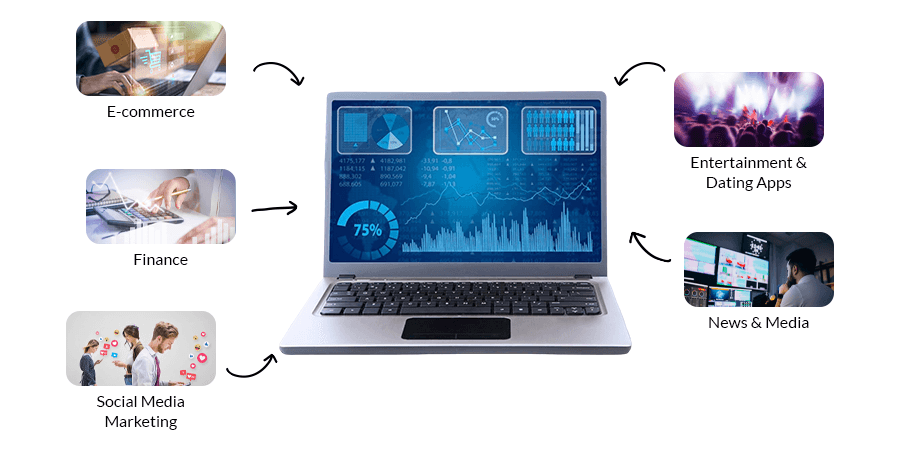In order to stay competitive, companies require real-time data in this ever-changing digital world. This is where live crawlers come in. Live crawlers do not work like traditional web scrapers, which operate on a schedule. Rather, they run every minute of the day and fetch relevant data as it is being created or modified.
Live crawlers offer businesses from various industries such as e-commerce, finance, and social media comprehensive real-time insights aiding timely decision-making about dynamic prices, market shifts, and client sentiment. Businesses benefit from live crawlers by never missing critical updates such as monitoring stock prices, monitoring competitor strategies, and social media discussions.
We’ll explore live crawlers in greater detail: what they are, how they function, their advantages over traditional scraping methods, and how they serve different industries.

What is a live crawler?
Live crawlers are an example of advanced web scraping tools. In contrast to scrapers that operate at standard intervals, they operate in real-time and fetch information the moment it goes live.
Imagine a news ticker that refreshes the latest headlines without entering a new page; this is exactly how live crawlers work. No matter if you are monitoring product prices, stock changes, or social media trends, these crawlers make sure that businesses will receive new, precise data without any delays.
This technology is especially useful for businesses that depend on immediate insights. Companies now can make timely decisions based on the latest information rather than outdated statistics. This provides them a strategic advantage in this fast-moving world of technological advances.
How Do Live Crawlers Work?
Live crawlers perform a continuous scan of websites to ensure they get the latest data the minute it becomes available. Unlike scrappers who work on schedule, they provide instant updates as they work in real-time and save a lot of time and effort.
Here’s how they function:
- Dynamic Adaptation to Website Changes: They actively check websites to record any changes that are made.
- Instant Data Collection & Processing: With real-time updates, live crawlers will be able to extract, process, and store the changes immediately so as to keep the data current.
- Continuous Scanning & Monitoring: No changes will be missed as live crawlers are able to actively and passively track any shifts in web pages.
A live crawler application improves this technology by providing simple interfaces for real-time data monitoring. Unlike traditional batch processing scrapers, which gather data at designated periods, they provide real-time precision, which is of utmost importance to companies seeking instantaneous useful information.
Advantages of Using Live Crawlers
Live crawlers provide access to ever-changing data, enabling businesses to stay current without delays. They allow for instantaneous decision-making, efficient monitoring of rapidly changing content, and high-level flexibility for large automated data requirements. This benefits businesses whose operations are sensitive to the constant flow of accurate data.
- Access to Real-time Data: Businesses may fail to capitalize on time-sensitive opportunities in a changing environment due to outdated information from traditional scrapers. Immediate notifications provided by live crawlers ensure businesses always use the most up-to-date information.
- Improved Decision-making: Finance, e-commerce, and social media are continuously evolving fields. The need for up-to-date information cannot be overstressed. By employing real-time data scraping, firms are able to make the most of emerging opportunities, changing consumer behavior, and new market competitors.
- Efficient Tracking of Dynamic Content : Live crawlers are effective for tracking dynamic data such as social media mentions, product prices, stock values, and even news articles. This enables businesses to analyze trends as they happen and keep ahead of the competition.
- Automation & Scalability: With web page live crawlers, a company can monitor a few to thousands of web pages without any human supervision, which makes these crawlers ideal for large-scale data extraction. For businesses with large information volumes, these tools provide unparalleled value due to their ability to manage extensive data automatically.
Industries Using Live Crawlers
- E-commerce: Online retailers heavily depend on live crawlers as they monitor prices, inventory levels, and competitor pricing. This allows the business to modify its pricing and stock strategies based on competition, ensuring the business remains profitable.
- Finance: Time is of utmost importance in the financial market. Investors, analysts, and bankers perform real-time data scraping in order to monitor stock prices, analyze, and keep track of ever-changing financial news to make smart business moves. Instant access to financial news improves investment strategies and minimizes risks.
- Social Media and Marketing: Social media monitoring is performed with live crawling technologies to understand social media discussions, competitor campaigns, and audience sentiment. This also enables businesses to quickly adapt to new trends, improve marketing strategies and optimize digital interactions with customers.
- Entertainment and Dating Apps: Dating apps leverage live crawlers to update users on profile changes in real-time, suggest matches, and analyze user activity. Live crawler dating apps automatically update data, resulting in a better user experience.
- News and Media: Live crawlers allow a news aggregator or media house to extract breaking news and updates as well as trending stories instantly from numerous sources. Real-time content curation can engage a large number of audiences.

Live Crawler vs. Live Crawler App: What’s the Difference?
Live crawlers are sophisticated web scraping tools built to extract and update data in real-time. It keeps an eye on web pages every second, collecting the most recent information available at all times. They are adopted by organizations in nearly every sector, e.g. finance, e-commerce, and media, for price watching, stock movement monitoring, and up-to-date news tracking.
On the contrary, a live crawler app is an example of an application developed with live crawling technology. It is aimed toward a particular user and has straightforward designs as well as specific features tailored to the user’s needs. For instance:
- E-commerce Platforms: A live crawler app can monitor competitors’ prices and inform businesses when changes need to be made.
- Social Media Engagement Tracking: Brands utilize these applications to monitor mentions, hashtags, and real-time engagement along different timelines.
- Finance & Stock Market: Investors depend on live crawler apps to get real-time information on stock prices, enabling quick business decisions.
- Dating Applications: A live crawler app in the dating niche retrieves real-time profile changes, suggested matches, and logged-in users to enhance user experience.
While live crawlers operate as backend data collection systems, live crawler apps provide this feature to users through interfaces that are customized to specific requirements.
Challenges in Live Crawling & Methods For Resolving Them
- Website Restrictions and Anti-Scraping Measures: Numerous websites incorporate CAPTCHA, IP address blocking, or robot detection systems to protect their data.
Solution: These limitations can be overcome using rotating proxies, headless browsers, and human-like surfing techniques. - Managing Massive Amounts of Data: The capture of continuous streams of data may put a lot of strain on servers and significantly degrade system performance.
Solution: Employing cloud-based infrastructure and streamlining data pipelines enable effective processing and purposeful application of resources. - Frequent Changes in Website Structure: Websites tend to change their layouts often, which results in breaking existing crawlers.
Solution: AI-powered dynamic crawlers with XPath selection are used for uninterrupted information capture and data flow. - Data Accuracy and Consistency: Data scraping must be done in real time, but information provided must be accurate, consistent, and reliable, original and free of errors.
Solution: Employing validation procedures, applying deduplication techniques, and automated checks during the process help maintain information accuracy and integrity. - Legal and Ethical Issues: Several data sources come with strict usage policies that, if breached, pose legal consequences.
Solution: Following ethical data scraping guidelines, abiding by robots.txt specifications, and utilizing data that is openly available ensures compliance.
In order to maintain accuracy and trustworthiness, the right tools and strategies must be adapted to overcome the challenges associated with live crawlers.
Future of Live Crawlers
There is a growing need for businesses to instantly access the latest data in order to be one step ahead of their competitors. With automation and AI becoming common, industries are adopting smarter data extraction tools that collect data, analyze and interpret it in real time. This procedure allows for the development of live crawlers that can provide practical insights, not just data.
In the future, live crawlers will integrate machine learning models that will increase data relevance and accuracy. These smart systems will also make data collection more seamless and robust by self-adapting to changes made on the website. Finance, e-commerce, and social media analytics will all rely on real-time data for timely decisions.
With industries becoming increasingly data-driven, live crawlers will offer incredible insight with instantaneous data extraction. Companies adopting this technology are sure to gain a competitive advantage by quickly adjusting pricing, forecasting demand, and adjusting their business models in response to changes in the market.
Conclusion
Live crawling provides businesses that work with large datasets with advanced tools for real-time monitoring and actively tracking changes. Unlike static web scraping, where data is collected over different periods, live crawling ensures accuracy and precision, enabling compatibility with other tracking tools that provide instant updates. Businesses no longer need to worry about losing crucial information updates with this cutting-edge technology.
Combining a live crawler app with business processes improves data collection and market monitoring.
Prevailing trends indicate that crawlers will continue to improve with advanced AI-powered automation. Businesses that capitalize on this shift will not only be relevant with upcoming innovations but also shape the future in an ever-changing digital world.











